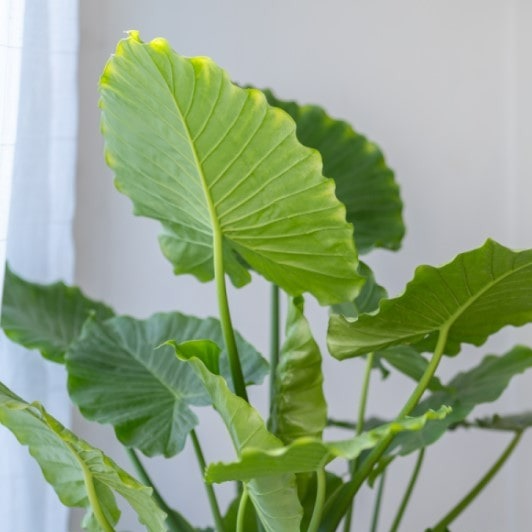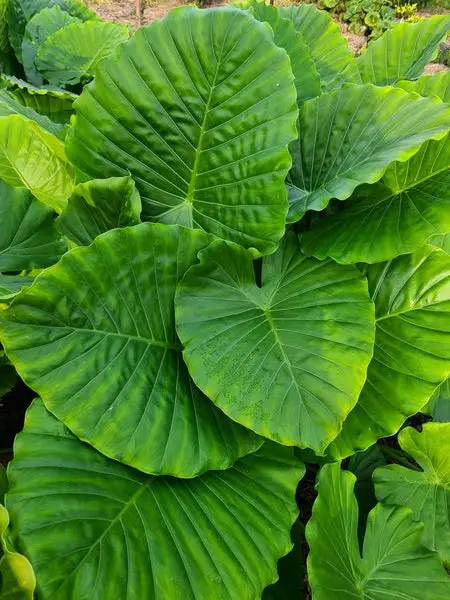The Alocasia California is a popular houseplant known for its striking foliage and unique shape. To care for it properly, provide bright, indirect light, maintain humidity levels, and water it when the topsoil dries out. Regular fertilization during the growing season will also promote healthy growth.
Introduction to Alocasia California
Alocasia California, often referred to as the African Mask Plant, is a stunning addition to any indoor garden. This plant features large, arrow-shaped leaves that can grow quite large, making it a focal point in your home. Its dramatic appearance and vibrant green color attract plant enthusiasts and casual gardeners alike.

Native to tropical regions, Alocasia plants thrive in warm, humid environments. The California variety is particularly well-suited for indoor living due to its adaptability. However, it still requires specific care to flourish. Understanding its needs can help ensure that your Alocasia California remains healthy and vibrant.
Key Characteristics of Alocasia California
Before diving into care details, it’s essential to recognize what makes the Alocasia California unique. Here are some key characteristics:
| Characteristic | Description |
|---|---|
| Leaf Shape | Arrow-like with prominent veins |
| Height | Can grow up to 3 feet tall |
| Light Requirements | Bright, indirect light preferred |
| Watering Needs | Moderate watering; allow topsoil to dry |
Caring for Your Alocasia California
To keep your Alocasia California thriving, you must meet its specific care requirements. Here are the fundamental aspects of plant care:

Light Conditions
The Alocasia California thrives in bright, indirect light. Direct sunlight can scorch its leaves, leading to damage. If you notice your plant stretching toward the light, it may not be receiving enough. Consider moving it closer to a window or using sheer curtains to diffuse the sunlight.
Watering Practices
Watering is crucial for the health of your Alocasia California. The general rule is to water when the top inch of soil feels dry. Overwatering can lead to root rot, while underwatering can cause the leaves to droop. It is best to check the soil moisture regularly to maintain a healthy balance.
Humidity and Temperature
Being a tropical plant, the Alocasia California enjoys high humidity levels. Aim for humidity around 60% or higher. If your home is dry, consider using a humidifier or placing a tray of water near the plant. The ideal temperature range for this plant is between 65°F and 80°F.

Fertilization
Fertilizing your Alocasia California during its growing season can promote vigorous growth. A balanced fertilizer diluted to half strength can be applied every four to six weeks from spring through early fall. Avoid fertilizing in winter when the plant’s growth slows down.
Pests and Diseases
Like many houseplants, the Alocasia California can be susceptible to pests and diseases. Identifying issues early helps in managing them effectively. Here are some common pests and diseases that may affect your plant:
Common Pests
- Spider Mites: These tiny pests thrive in dry conditions. They suck the sap from leaves, causing discoloration.
- Mealybugs: Known for their cotton-like appearance, mealybugs can weaken the plant by feeding on its sap.
- Scale Insects: These pests appear as small bumps on stems and leaves and can be difficult to detect.
- Fungus Gnats: These small flies are usually found in the soil and can harm young roots.
Signs of Infestation
Keep an eye out for the following signs of pest infestation:
- Yellowing or drooping leaves
- Visible insects on the plant
- Sticky residue on leaves (honeydew from pests)
- Webbing on leaves (indicative of spider mites)
Managing Pests
If you notice any signs of pests, take action promptly to avoid further damage. Here are effective methods to manage pests:

- Isolation: Immediately isolate the affected plant to prevent the spread of pests to other plants.
- Manual Removal: For larger pests like mealybugs, use a cotton swab dipped in rubbing alcohol to remove them manually.
- Insecticidal Soap: Spray your plant with insecticidal soap to eliminate soft-bodied insects like aphids and spider mites.
- Nematodes: For fungus gnats, consider using beneficial nematodes that target the larvae in the soil.
Diseases to Watch For
In addition to pests, various diseases can affect the health of your Alocasia California. Here are some common diseases:
- Root Rot: Caused by overwatering, root rot can kill your plant if not addressed early. Signs include mushy roots and yellowing leaves.
- Leaf Spot: Fungal infections can cause dark spots on leaves. This often occurs due to excess moisture on the leaves.
- Powdery Mildew: A fungal disease that appears as white powder on the leaves, often due to poor air circulation and high humidity.
Treating Diseases
If your Alocasia California shows signs of disease, consider these treatment options:
- Improve Drainage: Ensure that your pot has adequate drainage holes. Use well-draining soil to prevent water accumulation.
- Cull Affected Leaves: Trim away any infected leaves to prevent the spread of disease.
- Fungicides: Apply appropriate fungicides if a fungal infection is suspected. Always follow the manufacturer’s instructions.
Repotting Your Alocasia California
As your Alocasia California grows, it may require repotting every couple of years. Repotting offers fresh soil and more space for growth. Here’s how to do it correctly:
When to Repot
You should consider repotting your plant when you notice the following signs:
- The roots are growing out of the drainage holes.
- The growth has slowed down significantly.
- The soil dries out too quickly after watering.
Steps for Repotting
- Select a New Pot: Choose a pot that is one size larger than the current pot. Ensure it has drainage holes.
- Prepare Fresh Soil: Use a well-draining potting mix suitable for tropical plants.
- Remove the Plant: Gently remove the plant from its current pot, being careful not to damage the roots.
- Place in New Pot: Position the plant in the center of the new pot, and fill in with fresh soil, ensuring no air pockets remain.
- Water Thoroughly: After repotting, water the plant well to help settle the soil around the roots.
Caring for your Alocasia California involves attention to its specific needs regarding pests, diseases, and repotting. By following these guidelines, you can help ensure your plant thrives beautifully in your home.
2>Propagation of Alocasia California Propagation is an exciting way to expand your collection of Alocasia California plants. It can also help rejuvenate a mature plant. There are several methods for propagating this species, each with its unique steps. The most common methods include division and offsets. Dividing your Alocasia California is one of the simplest methods of propagation. This technique involves separating the plant’s rhizomes to create new plants. Here’s how to do it: Offsets are small plants that grow at the base of the main plant. These can also be used for propagation. Follow these steps for offset propagation: While Alocasia California is a hardy plant, it can still face certain challenges. Understanding these issues will help you address them effectively. If you notice yellowing leaves, it may indicate several problems: Browning edges on leaves can be distressing. This issue is often related to environmental factors: Drooping leaves may indicate stress in your plant: I f you are growing your Alocasia California indoors, there are specific considerations to keep in mind to ensure optimal growth: Indoor lighting can vary greatly. Ensure that your Alocasia California receives adequate light by placing it near a window that receives bright, indirect sunlight. If natural light is limited, consider using grow lights to supplement. Indoor plants can still attract pests. Regularly inspect your Alocasia California for signs of problems and maintain cleanliness around the plant by removing fallen leaves and debris. Alocasia plants do not thrive in cold drafts. Keep them away from doors and windows that open frequently during colder months. Caring for Alocasia California requires attention to detail, especially regarding propagation and common issues. By understanding these aspects, you can keep your plant healthy and thriving indoors or outdoors. T o ensure your Alocasia California remains a vibrant and healthy plant, consider these additional tips that can enhance its growth and overall health: As the seasons change, so do the needs of your Alocasia California. During the growing season, which typically spans from spring to early fall, the plant will require more care: During winter, your Alocasia California will enter a dormant phase. Here are some modifications to consider: The choice of potting mix plays a significant role in the health of your Alocasia California. A well-draining mix is essential to prevent root rot. Consider using: The large leaves of the Alocasia California can collect dust and debris, which may hinder their ability to photosynthesize effectively. Regularly clean the leaves using a soft, damp cloth to keep them shiny and healthy. Caring for an Alocasia California can be a rewarding endeavor for both novice and experienced plant enthusiasts. By understanding the specific needs of this beautiful plant, you can create an environment that allows it to thrive. Remember to provide adequate light, humidity, and water while being mindful of pests and diseases. Propagation techniques such as division and offsets offer an opportunity to expand your plant collection while nurturing your existing plants. Seasonal adjustments and proper potting mix are crucial for maintaining the health of your Alocasia California throughout the year. With attention to detail and a little patience, your Alocasia California can flourish, adding beauty and life to your indoor space. Embrace the journey of caring for this stunning plant, and enjoy watching it grow and thrive in your care.Propagation by Division
Propagation by Offsets
Common Issues with Alocasia California
Leaf Yellowing
Browning Leaf Edges
Drooping Leaves
Special Considerations for Indoor Growing
Lighting Conditions
Pest Prevention
Avoiding Drafts
Additional Tips for Thriving Alocasia California
Seasonal Adjustments
Winter Care
Choosing the Right Potting Mix
Maintaining Leaf Health
Final Thoughts
